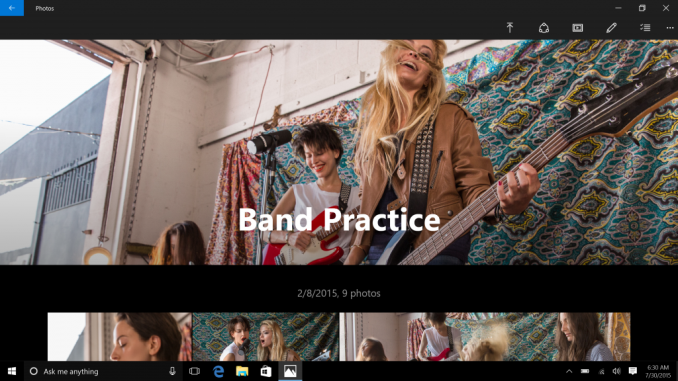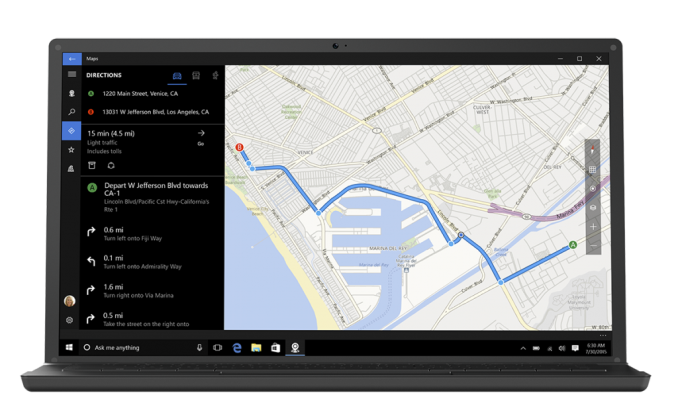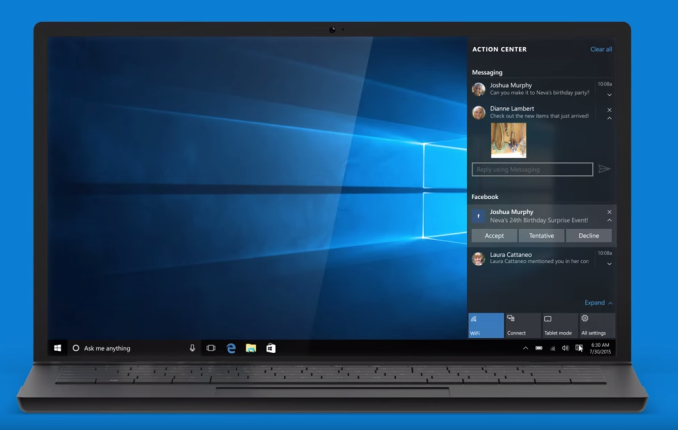The Windows 10 Review: The Old & New Face of Windows
by Brett Howse on August 25, 2015 8:00 AM EST- Posted in
- Operating Systems
- Microsoft
- Windows 10
Photos
Another app that was in desperate need of attention was Photos. The Windows 8 photos app was frankly a nightmare, and it was one of the first things I disabled on any new install. The new version is far superior to what came before, in both looks and functionality.
Once again, we have a Universal Windows App which means that it can scale and reflow to fit any display size or window. By default, it grabs pictures from your pictures folders in your user profile as well as OneDrive, and you can also toggle whether or not to show pictures from OneDrive which are not synced with your PC.
Once in the app, you can browse photos by your collection, which shows all photos, or by albums. Collection is pretty self explanatory, and just contains a list of all photos in chronological order. There is no way to sort any other way, although you can click on a month to jump to another date. The albums view is a lot different though, and the system will automatically create albums based on time and location in your photos, and then present them to you. You can change what photos are in the album if you want to.
The Photos app does some nice things like automatically not displaying duplicate photos, and it can clean up images and remove red-eye in a non-destructive manner. If you don’t like the auto-enhance, it can be turned off.
The Photos app is now the default app for viewing pictures, and it supports most photo and video file types, and they recently added GIF support which is one format that was left out of the previous photos app in Windows 8.
It is a good improvement over the Windows 8 version, and being a Universal Windows App means it supports high DPI and multiple display sizes. I’d like to be able to create my own albums, and that is not possible yet. The change is going to be pretty drastic for those coming from Windows 7 though, and people tend to not like change.
Maps
I’d be curious to see how many people use mapping in an app on the desktop compared to mobile systems. I tend to gravitate to the web on my desktop when I need mapping capabilities. But with Windows 10 going to be deployed on everything from phones to Xbox, having mapping as an app is obviously important.
Microsoft leverages HERE for their mapping technology, and while Nokia recently sold the HERE divisionto a group of automotive companies, the licensing arrangement is likely part of that transfer. Mapping is a very personal experience though, and some people may love HERE maps while others can’t use them because they are missing local information. It’s an incredibly difficult industry to get into and keep up to date. Google is the obvious competitor here, and they have spent a lot of money and time to build up their mapping to the point it is now. HERE has some street view, but none in my area. One thing HERE has been working on though is interior views of places like malls. I’ve used this before on the phone and it is pretty handy although it appears to be missing from the data available right now on Windows 10.
The mapping app itself is fairly well sorted out, and it can easily do directions or searches as you would expect. The views themselves can be either from straight overhead, or you can get a bird’s eye view as well and tilt and pan the camera. On a standard 2D map this can give you a nice sense of direction, but in some locations, the maps have 3D views as well which is a very nice effect. 3D views are only available in select areas, but they are a great way to find your way around when you can use them.
Another great feature of Maps which is built right into Windows 10 is the ability to download and manage offline maps. You can pick your area and have the maps ready to go without having to wait for the lag of your internet connection. It appears to only work with the road maps though and not aerial views which makes sense when you think about how much data you would need to download for aerial views of anywhere larger than a city.
The performance of maps on the devices I have tested it on is very good. Clearly this is all being offloaded to the GPU because the rendering is fast, and rotations and panning is very smooth. Once you get into the 3D maps though it can tax the system quite a bit. I still found performance good even on integrated graphics, but on laptops it is going to create some heat to get rid of since the GPU can draw a lot of power, even on integrated devices.
Maps are good on the desktop, but you can see that this app is one that will be more important on smaller devices running Windows 10, since you’ll be able to have your offline maps available for use on the go.
Messaging
When Windows 10 was shown off in January, one of the apps that was shown was a new messaging app. Windows 8 included both a touch based Skype app, and the traditional full desktop app, but the touch version never seemed to offer as consistent of an experience as the desktop version. For Windows 10, it would be replaced with new standalone apps for messaging, phone, and video.
Windows 10 is now here, but delays in the messaging apps mean that for the moment, people who want to use Microsoft’s messaging service need to use the full desktop version of Skype, since the touch version has been removed from the store for all users except those on Windows RT.
Once the new messaging apps are released, I will check them out and see how well they work. Being based on Skype, the backend is at least well known and Skype itself has improved a lot as a messaging app over the last couple of years.














293 Comments
View All Comments
zman58 - Thursday, October 15, 2015 - link
"worlds largest and most obnoxious spyware"We really don't know exactly what data it sends back on the user and their system(s) do we? The EULA does not detail this for us. In fact, the EULA has you agree to whatever they desire from your system--for improving the product. The spyware option is purely opt-out, for those of us who know what opt-out means and are capable of figuring out how to opt-out.
Then once you can/do opt-out, how can you be assured you will remain opted-out through upgrades, hot-fixes, patches, and what-not?
Bottom line is that the vendor decides what and when they want to collect data from your system, you have absolutely no control over them. Read the EULA and consider what it means before you click "I agree". You might not want to click that button...
Perhaps using an alternative reliable, safe, secure, and private operating system might be a better approach. ...Well hello there Linux.
bs grinder - Tuesday, December 26, 2017 - link
thanxjohn
ddriver - Wednesday, August 26, 2015 - link
"The privacy concerns are certainly not overblown, but for most people, they will make the trade-off of less privacy if it means an improved experience. The textbook example here is advertising, where in order to deliver relevant ads to the user"Ah yeas, I bet the whole world rejoices being able to give up their privacy to be blasted with ads. It is a great trade-off indeed.
"If you are concerned, the best thing to do is to read the privacy statement and adjust your settings accordingly."
I bet that's the best you can do, pretending that somehow clicking a button or two magically makes all problems go away
Also, I see a catch in those "privacy settings". You seem to only be able to turn off "sending MS info", but that doesn't imply that data is still not being mined and sent anywhere else.
imaheadcase - Wednesday, August 26, 2015 - link
You are aware these settings are present in almost almost win OS? The only privacy stuff they collect is related to MS services, onedrive, etc. Just because win 10 gave people options (gasp!) vs win 8 and 7 does not mean those did not, and still do have it.ddriver - Wednesday, August 26, 2015 - link
No they are not. Especially if you bother to watch what updates you install. For example, MS will try to sneak in the "telemetry" data miner service on your windows 7 as an update, but it is not there to begin with.I haven't used and will likely never use a windows version after 7, but in a "clean" windows 7 install none of the win 10 invasions of privacy are present. It doesn't keylog, it doesn't listen to speech, it doesn't analyze text or file content and it doesn't report everything you do back home.
Oh, and you can also chose not to install certain updates, whereas with the "nice free" windows 10 MS get to deploy on your system whatever it wants - all in the name of your comfort.
Michael Bay - Wednesday, August 26, 2015 - link
Your religious belief in 7 is amusing, at least.ddriver - Thursday, August 27, 2015 - link
If anyone around here is a believer, that is you, believing MS are trustworthy that is.Gigaplex - Friday, August 28, 2015 - link
If you don't trust MS, you shouldn't be using any version of Windows.althaz - Thursday, August 27, 2015 - link
FYI: Windows 7 collects telemetry by default. It was turned off by default in Vista and XP, but most OEMs turned it on for you. So Win 10 is collecting the same information as Windows XP, Vista and 7 (and 8), for most people.yuhong - Friday, August 28, 2015 - link
Does Win10 really "keylog" outside of search boxes and the like? search suggestions are not new either. There is no evidence that Win10 can read arbitrary files either.